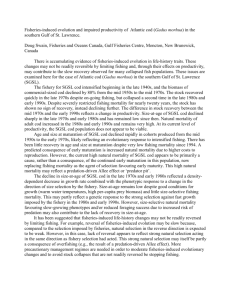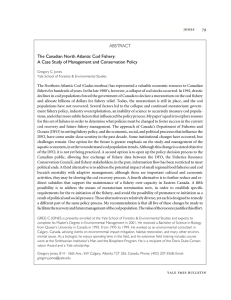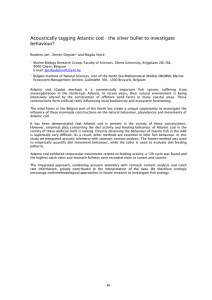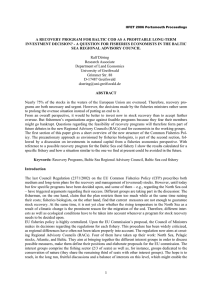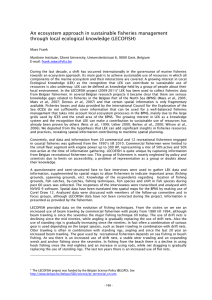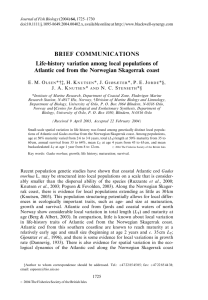Environmental and Worker Health & the viability of fishery communities
advertisement
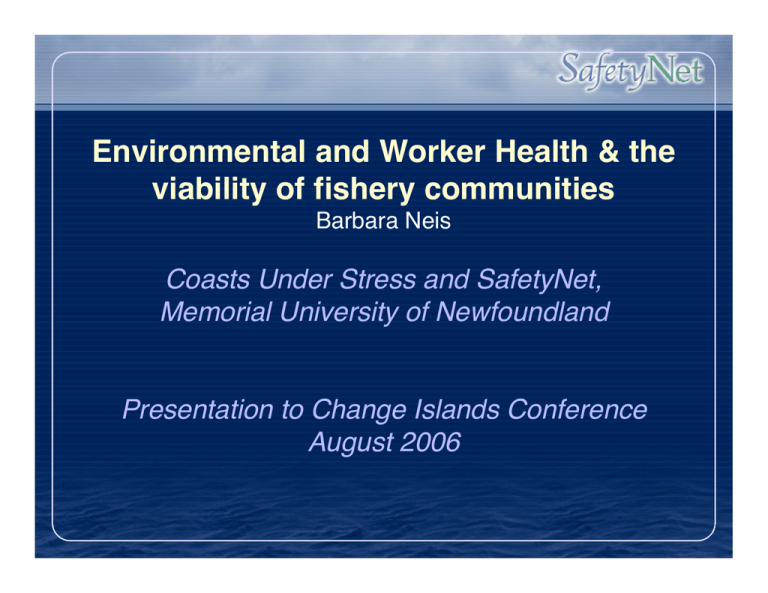
Environmental and Worker Health & the viability of fishery communities Barbara Neis Coasts Under Stress and SafetyNet, Memorial University of Newfoundland Presentation to Change Islands Conference August 2006 Funders and Partners Funded by the Social Sciences and Humanities Research Council of Canada (SSHRC) and the Natural Science and Engineering Research Council of Canada (NSERC), Here and globally we are fishing down the food chain Environmental Health: Managing for recovery makes sense Landed Value of 4R Fisheries – 2002 Total: $45,186,130 586,510 633,920 448,500 559,980 377,540 550,340 2,361,060 2,700,240 5,551,170 8,434,320 13,139,430 9,843,120 Northern Prawn and Pink Shrimps combined American Lobster Queen Crab Atlantic Cod Atlantic Mackerel Atlantic Herring Greenland Halibut Atlantic Halibut Capelin Atlantic Redfishes (Ns) Witch Flounder TOTAL - Other Species Cod should be central to Recovery What Could 4R Cod be Worth? 60 Mid 1950s: 2002: 3,937 t 2003 prices: around $1.41/kilo Millions of Dollarss around 35,000 t. 9x! 50 40 30 20 10 0 1954 Northern Cod – 250,000 t = ? 2003 Are we managing for recovery? • Some progress but science still tends to follow fisheries around • Eastport sustainable lobster fishery, collapsing in St. John Bay • One lobster scientist in NL • 15 years later – don’t know enough about stock structure, location of spawning areas, nursery areas, critical habitat… • Disagreements industry and scientists • Basis for disagreements? Way forward? Managing Cod for Recovery? • $1.2 million in research and a commercial and recreational cod fishery that could take more than 5,000 mt legally – is this “experiment” worth the risk? • Catch rates in commercial fishery- what will they tell us? • No science from recreational fishery – no data • Risk of enhanced poaching … • Risk of high-grading – data fouling – and targeting of larger, older fish… $5 million spent a different way Fishermen’s knowledge: local stocks, protect the mother fish, spawning areas … • Community-based science – bring youth home • Acoustic surveys using fishing vessels • More tagging in inshore waters • Identifying and closing spawning areas and nursery areas • Beach seine surveys for juvenile cod • Protection of habitat – Mapping goose grass. • Designing fisheries to protect young, old, egg-bearing cod, as in lobster • Investment in stewardship development • Improving prices so need to take less to survive • Improved fuel efficiency, reduced insurance costs • Development of tourism and eco-tourism linked activities • Paying for it? From taxes – stewardship isn’t free and won’t come through fishing alone Fishing Occupational Health & Safety On an industry basis, fishing has one of the highest potential for risks for accidents: How safe is our fleet? Are vessels designed to be safe work platforms? Fish harvester focus groups • CUTTING COSTS, THE COSTS OF CUTTING • technologies cost money • enterprises cut costs by dumping insurance, cutting crew – can increase risk • QUOTAS • IQs reduce risk involved in competitive fishery • Trust agreements can take away IQ Safety gains • OTHER FACTORS • High risk of motion induced interrupts on vessels • fatigue – overlapping seasons, fishing from ports outside one’s home community • inexperienced crew – divisions of labour Health, Safety and Shellfish processing Shellfish processing workers are exposed to a broad range of health risks Occupational asthma and allergy: 1. Varied but overall high prevalence (16.3%) highly likely/almost certain snow-crab OAA among participating workers. 2. Higher among women workers (more years of exposure/higher exposure areas) Work-related Musculo-skeletal Disorders (Solberg, Molgaard, Vezina) 1. High prevalence of symptoms among surveyed workers: 89% for women, 82% for men 2. Escalating work burden as labour shortages increase and work force ages Legacy of Prevention Failure No systematic approach to prevention in industry and knowledge gaps Limited detection, prevention, diagnostic, rehabilitation capacity in rural areas Substantial burden of injury and disease in aging workforce - Work until can no longer work Scale of burden likely to be greatest in older plants/labour forces Threat to productivity and to industry profits When plant closes, the town/family are left with burden of illness Investment in improved OHS training/capacity

